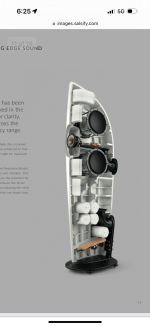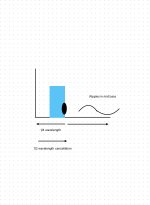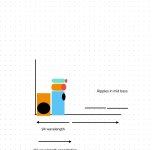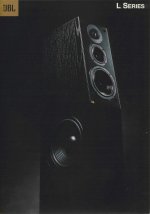Hi Jheaustin,
I was wondering if l had frightened you off.
These are my thoughts after a quite review of what l think your trying to achieve
1. A music sub such as the high quality Troels design l posted. This will in fact easily operate up to 150 hertz giving you some margin. The 30 cm woofer requires a 40x40x40 cm box - with passive radiators
2. Given the specifications of the music sub you can operate mid bass sealed enclosure with just a single woofer over 150-500 range
This would be an optimal mid bass situation in a sealed enclosure. You could go up to 800 hertz if that’s what ya want to do.
If your using stereo music subs thus is quite workable with a 150 hertz crossover point. A single woofer would be okay down to 100 hertz.
In my experience an 8 inch mid bass is best from 120-150 hertz . The small cone area just isn’t suitable for dynamic chest thumping bass at 50 hertz. The sub will over power two 8 inch sealed woofers.
No, you didn't. I am just too busy to do much here. Thank you for the analysis.
I haven't seen enough reasons to change the POR at the top level, so still sticking to it. But I will incrementally do things and utilize partial functionalities of Wilmslow as much as possible.
Without starting a debate with AllenB who l respect sometimes contemporary loudspeaker transducer engineers and systems designers start with an active design.
There are no inductors, capacitors or resistors to consider and they can focus on optimal design characteristics. The commercialisation involves a passive network.
The discontinued Pass XVR1 active cross over was conceived for development of Pass loudspeakers. I cloned this active crossover back in the mid 2000’s and used it to test and compare several different ideas before settling on a driver set up which l still use.
On the subjectivity front in theory yes a passive crossover should be comparable. But sometimes drivers interfere with each other in different pass bands due to the motional impedances interacting. Conjugated networks and tank circuits can help isolate these issues but they add complexity, cost and are not always 100% effective.
The impedance peaks in a bass reflex system cause a kink in the woofer voltage drive due to the voltage drop across a series inductor. The kink can in practice affect the flatness of the woofer bass response in the 40-150 hertz region.
The dcr of the low pass filter inductor should be accounted for when determining the port frequency because it effectively influences the QTS.
Are these issues audible. In some instances unfortunately yes. See the appraisal of the JBL XPL200 in which the full passive system is compared to the bi amp active system.
It really comes down to how fussy or refined you want your diy loudspeaker to be? My recommendation is start with a simple but elegant design and go from there.
https://www.audiophilenirvana.com/audiophile-equipment-reviews/jbl-xpl-200a-holy-grail/
There are no inductors, capacitors or resistors to consider and they can focus on optimal design characteristics. The commercialisation involves a passive network.
The discontinued Pass XVR1 active cross over was conceived for development of Pass loudspeakers. I cloned this active crossover back in the mid 2000’s and used it to test and compare several different ideas before settling on a driver set up which l still use.
On the subjectivity front in theory yes a passive crossover should be comparable. But sometimes drivers interfere with each other in different pass bands due to the motional impedances interacting. Conjugated networks and tank circuits can help isolate these issues but they add complexity, cost and are not always 100% effective.
The impedance peaks in a bass reflex system cause a kink in the woofer voltage drive due to the voltage drop across a series inductor. The kink can in practice affect the flatness of the woofer bass response in the 40-150 hertz region.
The dcr of the low pass filter inductor should be accounted for when determining the port frequency because it effectively influences the QTS.
Are these issues audible. In some instances unfortunately yes. See the appraisal of the JBL XPL200 in which the full passive system is compared to the bi amp active system.
It really comes down to how fussy or refined you want your diy loudspeaker to be? My recommendation is start with a simple but elegant design and go from there.
https://www.audiophilenirvana.com/audiophile-equipment-reviews/jbl-xpl-200a-holy-grail/
I also think as a very high-level non-engineering terms, the single powerful amplifier for a sophisticated passive network of a costly multi-way speaker costs a lot more than all 3 or more smaller amplifiers of same or comparable quality level cost altogether.
I used a $2Kish 9-ch home theater amplifier for the Wilmslow, and I don't think any stereo amplifier costing around $5K ~ 7K can match the total quality.
I used a $2Kish 9-ch home theater amplifier for the Wilmslow, and I don't think any stereo amplifier costing around $5K ~ 7K can match the total quality.
macka, I build using all crossover types including hybrids. The primary limitation is our own skill level.
Plenty of speakers sound fine with a passive crossover between midrange and tweeter. But with bass.... I could never again live with a passive woofer - ever!as one of the first true modern steps into much better loudspeakers. Simply adding direct amplification and EQ to the woofer, improved everything.
And when I like "slim" main towers - subwoofers are mandatory. I've never really heard any small speakers sound impactful - only boomy. I only very rarely heard a ported speaker sound good. Closed speakers have way lower sensitivity and extension in smaller cabinets.
Well... that leaves me with 4 ways. tweeter, midrange, two woofers and 2-4 subwoofers.
Maybe 3 way could go.... like Geddes, with very big mains and subwoofers. But even Sigberg Audio go 4 way with a 12" mains woofer - well - the cardioid definitely does have a play in this.
digitalthor, that’s another misconception.
It is not the passive crossover.
It was well understood in the old valve amplifier days that woofer damping is adjustable and arbitrary. You need to design a woofer resonance for a damping target in the electrical and mechanical domain (they are linked and one can compensate the other since they are a minimum phase property). It was also common to try different output taps when there was no other option. Simply increasing your box size or modifying your damping is one of several ways to do that.
Even simple EQ fixes this.
It is not the passive crossover.
It was well understood in the old valve amplifier days that woofer damping is adjustable and arbitrary. You need to design a woofer resonance for a damping target in the electrical and mechanical domain (they are linked and one can compensate the other since they are a minimum phase property). It was also common to try different output taps when there was no other option. Simply increasing your box size or modifying your damping is one of several ways to do that.
Even simple EQ fixes this.
So true - sorry Allen 😊Edit: digitalthor, you seem to have misquoted the above. I don’t recall saying that.
Please moderators, delete/correct the quote... because I think I might have deleted some text during writing, and then "pulling" my own text into the quoting area, where Allen's text was to begin with.
Partly agree... I just haven't really heard that yet in full practical function. And it is so much easier to just build a closed box, aim for a Q of 0,7-0,9 and then EQ at line level.digitalthor, that’s another misconception.
It is not the passive crossover.
It was well understood in the old valve amplifier days that woofer damping is adjustable and arbitrary. You need to design a woofer resonance for a damping target in the electrical and mechanical domain (they are linked and one can compensate the other since they are a minimum phase property). It was also common to try different output taps when there was no other option. Simply increasing your box size or modifying your damping is one of several ways to do that.
Even simple EQ fixes this.
I often think people need to do like in basic school. Write down a goal and some wishes for a given project - then boil it down and slowly understand each compromise. Then you kinda create a matrix, so that you can see what each choice require of each of the other choices. By then you can maybe create a part-conclusion, and readjust your goal with new experiences and thoughts in mind - maybe a readjusted budget or an acceptance of a given look/design - like accepting a tad wider baffle or shape.
This is what happened when I got a thread reopened about woofer choices, and several kind members helped me put things into perspective, by photoshopping different drivers into the same cabinet - side by side. Putting curves of distortion and frequency response on top of each other for easier comparison and in general just boiling it down 🤓
You also have to accept your limitations. I like electronics and mechanics, but I just found active speakers with multiple drivers and separate subwoofers, way, way WAY easier to integrate and adjust, with active filters - so that's my choice - even though somebody else might succeed with a passive approach.
Total respect to you guys, that build and create things that I can't
 But I had to cut some corners, and borrow a ton of knowledge and ideas from others, to get where I am today 😆
But I had to cut some corners, and borrow a ton of knowledge and ideas from others, to get where I am today 😆3 or 4 way? I love my 4 way system - even with the compromises 😀
I couldn't want for more than that. CheersI love my 4 way system

You also have to accept your limitations. I like electronics and mechanics, but I just found active speakers with multiple drivers and separate subwoofers, way, way WAY easier to integrate and adjust, with active filters - so that's my choice - even though somebody else might succeed with a passive approach.
Hello
That is exactly how I started! I didn't have the skills or tools to do passive crossovers so I went the active route. This was a while ago so no DSP just Analog active 24dB L/R active crossovers and URIE 539 cut only 31 band EQ added a Rane with 1/8 octave for the subs.
Almost 20 years later and this system except for some driver and horn changes has essentially remained unchanged.
I love my 4 way system - even with the compromises 😀
Me too it just checks the right boxes for me!
Rob 🙂
There are some great insights from experiences here.
Jheaustin,
To respond to your post 583 in my experience a large higher power class AB or digital power amp is best for the woofer and sub while a smaller high quality class A amp like any of the FirstWatt diy smps are superior for the mid and the tweeter.
Its a difficult thing to quantify but l recall explaining to Kent English at Pass Labs that l preferred the Aleph 3 diy amp or the diy AX Aleph in a bi amp situation with it on the mid range and treble drivers. This is particularly the case if you have a four way design that has piston range type accuracy. Here l like to bi amp a four way at the woofer - midrange crossover point around 250-300 hertz.
There are numerous hypotheses for this. I simply let me ears tell me what works.
I have also messed with the Jfet kit crossovers in the Diyaudio store. The Fairchild jfet version screams sound quality way above any monolith pa type active crosso
It’s simply sounds better. At least that is the consensus from people l know with jbl systems.
Jheaustin,
To respond to your post 583 in my experience a large higher power class AB or digital power amp is best for the woofer and sub while a smaller high quality class A amp like any of the FirstWatt diy smps are superior for the mid and the tweeter.
Its a difficult thing to quantify but l recall explaining to Kent English at Pass Labs that l preferred the Aleph 3 diy amp or the diy AX Aleph in a bi amp situation with it on the mid range and treble drivers. This is particularly the case if you have a four way design that has piston range type accuracy. Here l like to bi amp a four way at the woofer - midrange crossover point around 250-300 hertz.
There are numerous hypotheses for this. I simply let me ears tell me what works.
I have also messed with the Jfet kit crossovers in the Diyaudio store. The Fairchild jfet version screams sound quality way above any monolith pa type active crosso
It’s simply sounds better. At least that is the consensus from people l know with jbl systems.
Back to the question how to fit your ideas into an acceptable aesthetic package while achieving an acceptable acoustic solution.
I had a look at the specifications of the Kef Blade to see how they blended the side firing woofers. They cross at 350 hertz. That is interesting.
In as much as you want a rear separate sub l believe you can come up with a better bass solution by looking at a crossover point of over 100 hertz by looking at it as a woofer not a sub in the conventional sense.
Crossing over at 40 hertz or whatever your sealed dual 8 inch woofer idea is a home theatre approach for elf bass.
Because you are seeking better bass my recommendation is to put your money into a premium 10 or 12 inch woofer like these from CCS. They can operate either sealed or ported or a passive radiators over 100 hertz.
These woofers can operate in enclosure of 1.4 cuft3 ported. They also have a 10 inch version.
The response can be EQd in your dsp to exactly blend your mid bass - lower mid driver from 150-400 hertz. Crossover over below 100 hertz can invite continuity problems between your mid bass driver and the sub.
I believe what your after is a much lower distortion woofer (not a elf woofer) with an advanced motor. I also believe you will not achieve a satisfactory result with dual sealed woofers looking for output at 50 hertz. It’s just not going to happen.
Looking at the key blade side placement with 350 hertz cross over does not seem to be a problem.
I also would be thinking outside the square at other drivers from the CCS guys like their mid bass driver. Frankly l believe Scan speak and Seas are skimming the diy market via retailer margins to the point that you should seriously look at smaller specialty brands like
CCS and MISCO which have full documentation!
Do not be conned by the Scan speak marketing. Their main business is OEM completing with Tang bang and Sb acoustic.
It’s what’s put into a driver and the quality of the design and implementation that matters.
https://www.css-audio.com/online-store/Raw-Drivers-c30441934
MISCO also manufactures high quality drivers with full Klippel documentation
https://www.miscospeakers.com/why-m...ces#cutting-edge-klippel-vibrational-analysis
Dual gap woofers are state of the art.
https://store.miscospeakers.com/6-5...MH*MTcyMTIwNzUyNi4yLjEuMTcyMTIwODE5OC4wLjAuMA..
https://store.miscospeakers.com/amfile/file/download/file/536/product/237/
https://store.miscospeakers.com/bold-north-audio-neo-classic-bdt-2901-dome-tweeter
The the attached sketch the woofer enclosure could be integrated into the main enclosure with dimensions of 16.5 x 35x 80 cm. The front facing mid - bass driver single cone would neatly sit on top of your woofer enclosure.
I would look at modelling clay to come up with an egg shaped enclosure that your Satori 60mm dome mid and tweeter could fit into.
Once you have the shape it will go hard in a few days. Then spray paint it with an aerosol can pack.
https://www.amazon.com.au/BOHS-Squi...1&psc=1&mcid=a172c639eb693d268a2cdf48b350bb61
I had a look at the specifications of the Kef Blade to see how they blended the side firing woofers. They cross at 350 hertz. That is interesting.
In as much as you want a rear separate sub l believe you can come up with a better bass solution by looking at a crossover point of over 100 hertz by looking at it as a woofer not a sub in the conventional sense.
Crossing over at 40 hertz or whatever your sealed dual 8 inch woofer idea is a home theatre approach for elf bass.
Because you are seeking better bass my recommendation is to put your money into a premium 10 or 12 inch woofer like these from CCS. They can operate either sealed or ported or a passive radiators over 100 hertz.
These woofers can operate in enclosure of 1.4 cuft3 ported. They also have a 10 inch version.
The response can be EQd in your dsp to exactly blend your mid bass - lower mid driver from 150-400 hertz. Crossover over below 100 hertz can invite continuity problems between your mid bass driver and the sub.
I believe what your after is a much lower distortion woofer (not a elf woofer) with an advanced motor. I also believe you will not achieve a satisfactory result with dual sealed woofers looking for output at 50 hertz. It’s just not going to happen.
Looking at the key blade side placement with 350 hertz cross over does not seem to be a problem.
I also would be thinking outside the square at other drivers from the CCS guys like their mid bass driver. Frankly l believe Scan speak and Seas are skimming the diy market via retailer margins to the point that you should seriously look at smaller specialty brands like
CCS and MISCO which have full documentation!
Do not be conned by the Scan speak marketing. Their main business is OEM completing with Tang bang and Sb acoustic.
It’s what’s put into a driver and the quality of the design and implementation that matters.
https://www.css-audio.com/online-store/Raw-Drivers-c30441934
MISCO also manufactures high quality drivers with full Klippel documentation
https://www.miscospeakers.com/why-m...ces#cutting-edge-klippel-vibrational-analysis
Dual gap woofers are state of the art.
https://store.miscospeakers.com/6-5...MH*MTcyMTIwNzUyNi4yLjEuMTcyMTIwODE5OC4wLjAuMA..
https://store.miscospeakers.com/amfile/file/download/file/536/product/237/
https://store.miscospeakers.com/bold-north-audio-neo-classic-bdt-2901-dome-tweeter
The the attached sketch the woofer enclosure could be integrated into the main enclosure with dimensions of 16.5 x 35x 80 cm. The front facing mid - bass driver single cone would neatly sit on top of your woofer enclosure.
I would look at modelling clay to come up with an egg shaped enclosure that your Satori 60mm dome mid and tweeter could fit into.
Once you have the shape it will go hard in a few days. Then spray paint it with an aerosol can pack.
https://www.amazon.com.au/BOHS-Squi...1&psc=1&mcid=a172c639eb693d268a2cdf48b350bb61
Attachments
Last edited:
There are some great insights from experiences here.
Jheaustin,
To respond to your post 583 in my experience a large higher power class AB or digital power amp is best for the woofer and sub while a smaller high quality class A amp like any of the FirstWatt diy smps are superior for the mid and the tweeter.
Its a difficult thing to quantify but l recall explaining to Kent English at Pass Labs that l preferred the Aleph 3 diy amp or the diy AX Aleph in a bi amp situation with it on the mid range and treble drivers. This is particularly the case if you have a four way design that has piston range type accuracy. Here l like to bi amp a four way at the woofer - midrange crossover point around 250-300 hertz.
I am doing a bit of what you said. I hopefully mentioned earlier that I use a Prima Luna tube amplifier for the mid using EL34 for 'pretty sound'. The Monolith amplifier is still powering the woofers and tweeters. I think the mid became to sound more liquid, forgiving, and pleasing.
I was thinking about something similar like First Watt, recommended by my friend, but don't have enough money for those yet. ;-). I think I will eventually do that for the D2104 tweeters in the new speakers.
There are numerous hypotheses for this. I simply let me ears tell me what works.
I have also messed with the Jfet kit crossovers in the Diyaudio store. The Fairchild jfet version screams sound quality way above any monolith pa type active crosso
It’s simply sounds better. At least that is the consensus from people l know with jbl systems.
I'll look into more of similar options after I dealt with the DSP crossover change and the speaker design.
Back to the question how to fit your ideas into an acceptable aesthetic package while achieving an acceptable acoustic solution.
I had a look at the specifications of the Kef Blade to see how they blended the side firing woofers. They cross at 350 hertz. That is interesting.
That is weird and surprising. I don't think I would go with such high crossover for side-firing ones.
In as much as you want a rear separate sub l believe you can come up with a better bass solution by looking at a crossover point of over 100 hertz by looking at it as a woofer not a sub in the conventional sense.
Crossing over at 40 hertz or whatever your sealed dual 8 inch woofer idea is a home theatre approach for elf bass.
Let me clarify this. The double-woofer module is a front-firing bass(or "woofer") module, meaning traditional woofer section. For the side-firing subwoofer modules in somewhat distant future, I'd use 12 ~ 15" drivers.
Because you are seeking better bass my recommendation is to put your money into a premium 10 or 12 inch woofer like these from CCS. They can operate either sealed or ported or a passive radiators over 100 hertz.
10" seems a bit too wide for the WAF...
These woofers can operate in enclosure of 1.4 cuft3 ported. They also have a 10 inch version.
The response can be EQd in your dsp to exactly blend your mid bass - lower mid driver from 150-400 hertz. Crossover over below 100 hertz can invite continuity problems between your mid bass driver and the sub.
I believe what your after is a much lower distortion woofer (not a elf woofer) with an advanced motor. I also believe you will not achieve a satisfactory result with dual sealed woofers looking for output at 50 hertz. It’s just not going to happen.
Looking at the key blade side placement with 350 hertz cross over does not seem to be a problem.
I also would be thinking outside the square at other drivers from the CCS guys like their mid bass driver. Frankly l believe Scan speak and Seas are skimming the diy market via retailer margins to the point that you should seriously look at smaller specialty brands like
CCS and MISCO which have full documentation!
Do not be conned by the Scan speak marketing. Their main business is OEM completing with Tang bang and Sb acoustic.
It’s what’s put into a driver and the quality of the design and implementation that matters.
https://www.css-audio.com/online-store/Raw-Drivers-c30441934
MISCO also manufactures high quality drivers with full Klippel documentation
https://www.miscospeakers.com/why-m...ces#cutting-edge-klippel-vibrational-analysis
Dual gap woofers are state of the art.
https://store.miscospeakers.com/6-5...MH*MTcyMTIwNzUyNi4yLjEuMTcyMTIwODE5OC4wLjAuMA..
https://store.miscospeakers.com/amfile/file/download/file/536/product/237/
https://store.miscospeakers.com/bold-north-audio-neo-classic-bdt-2901-dome-tweeter
The the attached sketch the woofer enclosure could be integrated into the main enclosure with dimensions of 16.5 x 35x 80 cm. The front facing mid - bass driver single cone would neatly sit on top of your woofer enclosure.
I would look at modelling clay to come up with an egg shaped enclosure that your Satori 60mm dome mid and tweeter could fit into.
Once you have the shape it will go hard in a few days. Then spray paint it with an aerosol can pack.
https://www.amazon.com.au/BOHS-Squi...1&psc=1&mcid=a172c639eb693d268a2cdf48b350bb61
My POR is to go with compromised bass performance, compensated by my SVS until I get my hands on the side-firing subwoofers. But that's a relatively far-away thing, and I might go with very deep sealed enclosures for 8"x2 woofer module to get the maximum out of it. I think I have an idea to accommodate the future subwoofers in an acceptable WAF range. As you suggested, Satori papyrus cones seem to be good candidates.
I understand.
I meant use something like the CCS drivers as a side firing driver ultimately. Not a sub woofer but a real woofer in the long term that can go up higher than the SVS.
In the short term if you can by experimenting with ian alternative separate “woofer” enclosure of 1.4 cu ft - 2 cu ft that can operate up much higher it might help you evolve the your design and overcome some of the dilemmas like the mid bass enclosure volume.
Dual mid bass drivers adds additional cost which you may not need.
This way you can rationalise you mid - bass driver situation down to just one driver. This then reduces the volume need and simplifies the whole system.
At the moment you are in a transitional stage and l get that. I’ve been in that situation.
I meant use something like the CCS drivers as a side firing driver ultimately. Not a sub woofer but a real woofer in the long term that can go up higher than the SVS.
In the short term if you can by experimenting with ian alternative separate “woofer” enclosure of 1.4 cu ft - 2 cu ft that can operate up much higher it might help you evolve the your design and overcome some of the dilemmas like the mid bass enclosure volume.
Dual mid bass drivers adds additional cost which you may not need.
This way you can rationalise you mid - bass driver situation down to just one driver. This then reduces the volume need and simplifies the whole system.
At the moment you are in a transitional stage and l get that. I’ve been in that situation.
Last edited:
Things like a diy F3 or F5 are not that expensive to build. I got involved in building diy power amps back in the late 1990’s. I initially built a JLH amp with the help of Hugh Dean who was build Aspen kits. (locally). I then got into the Aleph diy amps. The diy X Aleph was the most enjoyable subjectively. Very transparent. It made the hobby richer.
I while ago l bought Douglas Self’s book on active crossover. This was the analogue theory and design. But in the application he makes a very good point that placement of the woofer up against a wall significantly reduces 1/4 wave reflections off the wall. This results in a much smoother bass above 100 hertz. Logically a woofer placed sides is closer to the wall.
A 1/4 wave length of 344 hertz is 250 mm is ten inches. 1/4 wave of 150 hertz is 570 mm
The reflection off the wall cancels on return with the woofer at 180 degrees or 1/2 wavelength.
The further out in the room you move the loudspeaker the more ripples you get in the mid bass.
This can be at odds with obtaining the best sound stage.
So a separate woofer module place behind the main enclosure can solve some problems by getting the woofer much closer to the wall. If your main enclosure is deep then a side firing woofer would be an advantage.
It isn’t necessarily well known but Doug Self was the head of engineering at Soundcraft mixers for a long time. In his spare time he authored a number of books on power amplifier design. He influenced the approach to power amplifier design.
A 1/4 wave length of 344 hertz is 250 mm is ten inches. 1/4 wave of 150 hertz is 570 mm
The reflection off the wall cancels on return with the woofer at 180 degrees or 1/2 wavelength.
The further out in the room you move the loudspeaker the more ripples you get in the mid bass.
This can be at odds with obtaining the best sound stage.
So a separate woofer module place behind the main enclosure can solve some problems by getting the woofer much closer to the wall. If your main enclosure is deep then a side firing woofer would be an advantage.
It isn’t necessarily well known but Doug Self was the head of engineering at Soundcraft mixers for a long time. In his spare time he authored a number of books on power amplifier design. He influenced the approach to power amplifier design.
Attachments
Last edited:
10" seems a bit too wide for the WAF...
Here is a system JBL L7 that accommodates an 8 front firing driver with a "real" 12 " side mounted woofer. As an example t/s attached for crossover points as a reference.
Rob 🙂
Attachments
- Home
- Loudspeakers
- Multi-Way
- 4-way instead of 3-way?





